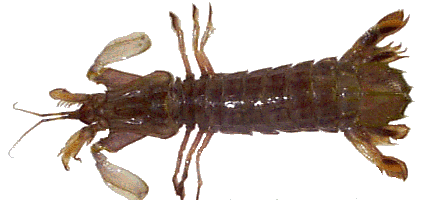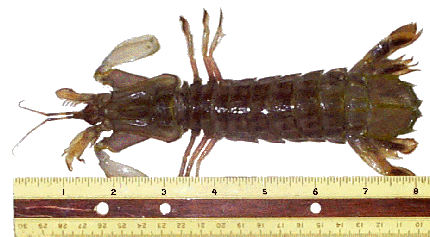Fish Id: A Guide To East Coast Fishes

Mantis Shrimp
Order Stromotopod, Family Nannosquillidae
6/4/98 We brought in several shrimp
and crawfish lures that may work as "mantis shrimp" imitations!
We received an e-mail message during the summer of '97, re: weird lobster-like creature found in Great Bay.........What is that thing?
My question, too. We had customers bring a few by to look at, but they
were in pieces, so I wasn't able to get a proper picture. March
'98, we get a complete specimen, and MizMo
goes to work with the digital camera and a research project for the page!
Hadrosqiulla perpasta, Hemiqiulla ensigera, Choridella empusa, Squilla empusa, Squillam Gonodactylus oerstedi??? I found many
Latin species names for this critter whilst I was researching, and discovered that there are many more varieties than I had expected---
some 60 or more in the areas around Florida alone. They range from Cape Cod to the Gulf of Mexico, and I found info about them in
Italy and Greece! Wow!
The Mantis Shrimp is a carnivorous crustacean, with a body design that looks more like a cross between a shrimp and a preying mantis than
a lobster, often right down to the coloration. We do get immature lobster in Great Bay, during the beginning of summer, in their last stage before becoming adult lobster, but the ones who stay don't develop into lobsters, because in the shallow water, temperatures
warm up too much and they die. The mantis shrimp is edible: the meat in abdomen can be eaten, like a lobster, but the quantity of meat is small. They like the shallow bay and coral reef areas, living on the sandy bottoms of the bay in burrows, or within crevices of rock, although some have been found out in deeper waters(down to 500 ft). They have been found during the fall in the gut contents of stripers, which seems to indicate that they might be tempted to hit on them as bait---and no, I don't have any idea how you would rig one up---you'd have to catch one first! Rutgers sometimes catches them when they work with their trawling nets.
I found some more detail on their physical characteristics.
They vary in color, but the most common is shadings of cream with light or dark green mottling, which is the coloration we have seen here in the Great Bay, NJ. Some varieties have stunning coloration in blues and reds. The mantis shrimp can grow as large as 12", locally we generally see them 5-6", but my specimen brought
in by one of our friends was 8". They have a jointed head (unlike other crustaceans), with forward placed mobile eyes, andsensory antennae. The claw is carried folded under the body in a tight Z, until used to strike it's prey, much like the preying mantis for which it is named.
The ferocious hunting techniques of these critters
put a deer hunter to shame, with stalking methods that are chilling to watch (hey, put yourself in that fish's place, and see how you feel about it! =) ). They lurk
under rocks and coral, often hunting from the frontof their burrow, but they will go out looking for food if necessary. When a tempting fish or crab comes close enough to this unseen peril,
wham! This crustacean is known for its formidable claws, nicknamed "thumb chopper", and with good reason. Mishandling a live one can result in sliced fingers. Handle with care, and as our friend Sue suggests always wear gloves. Some mantis shrimp
use the large forelegs as clubs to beat their prey, and others rely on sharp clawed forelegs (hence the nickname). These mantis shrimp spear their prey, then slice and dice
is on the menu. Fish, crabs, snails, and other small aquatic creatures are the food of choice, even a small squid, if the mantis can sneakup on it. I saw a special on that just the other day----which just added fuel to this project: a mantis shrimp was sneaking up on a blue-ringed
octopus, which evaded the predator, snuck up through the coral until it was behind the mantis, and stung it with one of it's poisonous tentacles, then it was lunchtime for the octopus. Wouldn't it be something if the deer turned on the hunters? Shudder!!!!
My thanks to Susan O'Brien, who was working out
at Rutgers Marine Research Center, for all her help in answering my questions last
summer!. MKA

Back to CRITTERS LIST or
Return to FishGuide | FishingPage